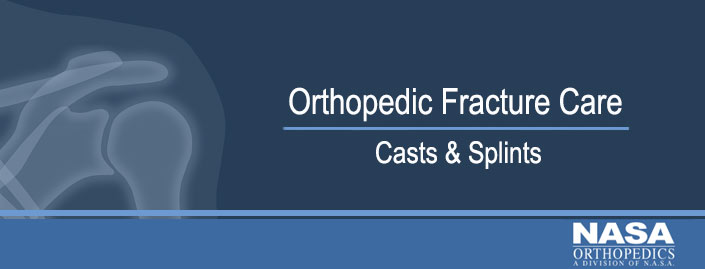Orthopedic Fracture Care: Casting & Splints

After the bone fracture procedure has been performed to reset your bone, a cast or splint is applied in order to hold the bone in place during the healing process. Casts and splints do more than keep the bone steady as it heals. Muscle spasms, swelling, and pain are reduced through the application of casts and splints.
Casts & Splints: What’s the difference?
Casts are created out of fiberglass or plaster, and many splints are made of the same materials. Every injury is different, but in many cases an injury that results in considerable swelling of the area will be treated with the use of a splint. This is because a splint allows for your doctor to adjust as the swelling decreases. Once swelling is reduced your doctor may put you in a cast to complete healing, and move back to a cast as you begin physical therapy.
Cast To heal, a cast needs to fit the shape of your body in the affected area. A cast is custom-made for your body. A cotton stocking and additional padding are placed over your skin for comfort before the casting process begins.
Fiberglass material is often the best option for casts. It is lightweight and X-ray scanners can see through fiberglass easier than plaster. Standard casts cannot get wet.
Splint Splints are often referred to as half-casts. They can be made of the same fiberglass or plaster materials as a cast, but there are also ready-made splints available. These are made with Velcro straps and are easily adjustable.
Cast Care & Maintenance
As with all aspects of your fracture procedure and care, your doctor will provide you with guidelines specific to your condition. Following his or her instruction will help your bone heal properly. Below you will find some general information on caring for your cast or splint.
- Keep it dry Your cast will need to be wrapped in waterproof material before showering or visiting the beach. Even waterproofed, do not submerge your cast in water.
- Keep it clean And speaking of the beach, don’t let sand sneak under your cast.
- Try not to mess with it It’s an inevitability that it’s going to get itchy under your cast, and this is often the hardest task for even the best patients. Don’t stick anything under your cast in an attempt to itch that scratch. If the edges of the cast are bothering you speak with your doctor before trimming them yourself.
- Keep an eye on it If you notice redness in the skin around the area contact your doctor. If the cast itself cracks, or if you notice soft spots call your doctor.
Methods to help reduce swelling
To help reduce swelling your doctor may recommend one or more of the following:
Elevate your injury for the first 48-72 hours
Apply ice to your splint or cast
Move your swollen fingers or toes (as long as they are uninjured) to help prevent stiffness.
Swelling Issues that may arise
The biggest concerns with casting arise from the pressure created by swelling under your cast. If you are experiencing the following symptoms contact your primary care physician. Be aware that for the first 48 to 72 hours pressure is common. Your doctor will speak to you about what you can expect, but if you have any concerns don’t hesitate to call.
• Increased pain
• Feeling of tightness in the cast
• Burning or stinging feeling
• Numbness or tingling in your hands or feet
• Loss of movement in toes or fingers
• Excessive cast swelling
Cast Removal
Your cast is removed with a cast saw. Don’t worry, it sounds worse than it is. A cast saw works with vibration. It doesn’t rotate so your skin may feel hot because of the friction, but you will not be harmed. Never try to remove the cast yourself.
Physical Therapy
Broken, fractured bones can take weeks or months to heal. During this time your injured limb will most likely lose muscle strength. Working with a physical therapist will help you to properly and safely rebuild any lost muscle strength, and restore motion and flexibility.
Bone Fracture Treatment in Naples, Florida
If you think you may have a bone fracture or break seek medical attention immediately. Signs include bruising, swelling, or pain in the injured area. A bone fracture may not be always be apparent. If you have been injured in a fall or accident always seek medical attention. The orthopedic specialists of Neuroscience & Spine Associates treat bone fractures and breaks in Naples and Fort Myers, Florida.

